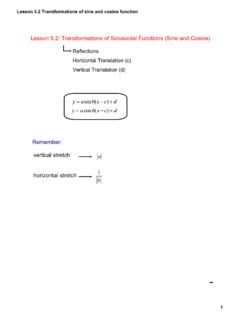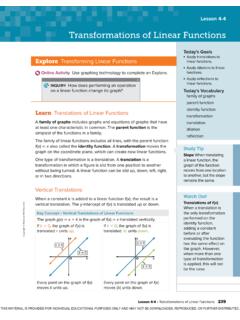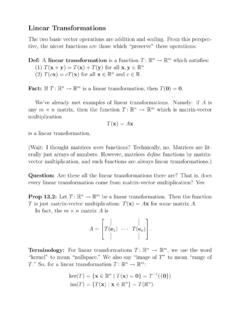Transcription of Transformations of Exponential Functions - MRS. POWER
1 Pre-Calculus 12A Section Transformations of Exponential Functions To graph an Exponential function of the form y a(c )b ( x h ) k , apply Transformations to the base function, y c x , where c > 0. Each of the parameters, a, b, h, and k, is associated with a particular transformation . Example 1: Translations of Exponential Functions Consider the Exponential function y 2x . For each of the transformed Functions , State the parameter and describe the transformation . graph the base function and the transformed function on the same grid. Describe any changes to the domain, range, intercepts, and equation of the horizontal asymptote. Explain the effect of the transformation on an arbitrary point, (x,y), on the graph of the base function.
2 A. y 2x 3. Solution: a. y 2x 3. Complete each table of values and then graph the Functions . y 2x x y -2. -1. 0. 1. 2. 3. 4. 5. y 2x 3 x y -2. -1. 0. 1 Comparing the graph of y 2x 3 to y 2x will allow you to 2 determine the value of the parameter k. k = _____. 3 This transformation indicates that the 4 graph of y 2x 3 moves _____. 5. compared to the graph of y 2x . For the function y 2x 3 , state the Domain: _____ Range: _____. x-intercept: _____ y-intercept: _____. Equation of the horizontal asymptote: _____ Mapping rule: _____. 1. Pre-Calculus 12A Section b. y 2x 5. y 2x x y -2 1. 4. -1 1. 2. 0 1 y 2x 1 2. 2 4. 3 8. 4 16. 5 32. Complete the table of values.
3 Draw the graph of the transformed function. y 2x 5 Mapping Rule: _____. X y Comparing the graph of y 2x 5 to y 2x will allow you to determine the value of the parameter h. h= _____. This transformation indicates that the graph of y 2x 5 moves _____ compared to the graph of y 2x . For the function y 2x 5 , state the Domain: _____. Range:_____. x-intercept: _____. y-intercept: _____. Equation of the horizontal asymptote: _____. 2. Pre-Calculus 12A Section c. y 4 2x 1. y 2x y 2x x y -2 1. 4. -1 1. 2. 0 1. 1 2. 2 4. 3 8. 4 16. 5 32. Complete the table of values. Draw the graph of the transformed function. y 4 2x 1 Mapping Rule: _____. x y Comparing y 4 2x 1 to y 2x will allow you to determine the value of the parameters h and k.
4 H= _____while k = _____. This transformation indicates that the graph of y 4 2x 1 moves _____. compared to the graph of y 2x For the function y 4 2x 1 , state the Domain: _____ Range: _____. x-intercept: _____ y-intercept: _____. Equation of the horizontal asymptote: _____. 3. Pre-Calculus 12A Section Example 2: Stretches of Exponential Functions x 1 . Consider the Exponential function y . For each of the following Transformations , 2 . State the parameter and describe the corresponding transformation graph the base function and the transformed function on the same grid Describe any changes to the domain, range, intercepts, and equation of the horizontal asymptote Show what happens to an arbitrary point, (x,y), on the graph of the base function x 1.
5 A. y 2 . 2 . Complete the tables of values. Draw the graph of the Functions . x 1 . y . 2 . x Y. -4. -3. -2. -1. 0. 1. 2. x 1 . y 2 Mapping Rule: _____. 2 . x Y. -4. -3 1 . x 1 . x -2 Comparing y 2 to y will allow you to determine the 2 2 . -1. value of the parameter a. a = _____. 0 x 1 1 . This transformation indicates that the graph of y 2 stretches 2 2 . _____ compared to the x x 1 1 . graph of y .For the function y 2 , state the 2 2 . Domain :_____ Range :_____. x-intercept: _____ y-intercept: _____. Equation of the horizontal asymptote; _____. 4. Pre-Calculus 12A Section 2x 1 . b. y . 2 . Complete the table of values. Sketch the graphs of the Functions .
6 X 1 . y . 2 . x y -5 32. -4 16. -3 8. -2 4. -1 2. 0 1. 1 1. 2. 2 1. 4. 2x 1 . y Mapping Rule: _____. 2 . x y 32. 16. 8. 4. 2. 1 2x x 1 1 . 1 Comparing y to y will allow you to determine the value 2 2 . 2 of the parameter b. b= _____. This transformation 1 2x 1 . 4 indicates that the graph of y stretches 2 . x 1 . _____ compared to the graph of y . 2 . 2x 1 . For the function y , state the 2 . Domain: _____ Range :_____. x-intercept: _____ y-intercept: _____. Equation of the horizontal asymptote; _____. 5. Pre-Calculus 12A Section 1. x 1 2. c. y 3 . 2 . Complete the table of values. Sketch the graphs of the Functions . x 1 . y . 2 . x y -4 16. -3 8.
7 -2 4. -1 2. 0 1. 1 1. 2. 1. x 1 2. y 3 Mapping Rule: _____. 2 . x y 1. x x 1 2 1 . Comparing y 3 to y will allow you to determine the 2 2 . value of the parameters a and b. a = _____ b = _____. 1. x 1 2. This transformation indicates that the graph of y 3 . 2 . _____. x 1 . _____as compared to the graph of y . 2 . 1. x 1 2. For the function y 3 , state the 2 . Domain: _____ Range: _____. x-intercept: _____ y-intercept: _____. Equation of the horizontal asymptote: _____. 6. Pre-Calculus 12A Section Example 3: Combining Transformations of Exponential Functions Consider the base function y 3x . For each transformed function, State the parameters and describe the corresponding Transformations Complete the table of values to show what happens to the given points under the Transformations Sketch the graph of the base function and the transformed function.
8 A. Describe the effects on the domain, range, equation of the horizontal asymptote, and intercepts 1 x 4. Complete each table of values and sketch the graph of the function y 3 . 3. x y 3. x y -2. -1. 0 y 3x 1. 2. 3. 4. 1 x 4. y 3 MAPPING RULE: _____. 3. X y 1 x 4. Comparing y 3 to y 3x will allow you to determine the 3. value of the parameters a, b, h and k. a= _____ , b = _____, h=_____, k= _____. 1 x 4. These Transformations indicate that the graph of y 3 . 3. _____. _____. as compared to the graph of y 3x . 1 x 4. For the function y 3 , state the 3. Domain _____ Range _____. x-intercept: _____ y-intercept: _____. Equation of Horizontal Asymptote : _____.
9 7. Pre-Calculus 12A Section b. y 3x X y -2 1. 9. -1 1. 3. 0 1. 1 3. 2 9. 3 27. X y Complete the table of values and sketch the graph of y 2(3) 2( x 1) 5. Mapping Rule: _____. Comparing y 2(3) 2( x 1) 5 to y 3x will allow you to determine the value of the parameters a, b, h and k. a= _____ , b = _____, h=_____, k= _____. These Transformations indicate that the graph of y 2(3) 2( x 1) 5 is _____. _____. as compared to the graph of y 3x . For the function y 2(3) 2( x 1) 5 , state the Domain :_____ Range: _____. x-intercept: _____ y-intercept: _____. Equation of the horizontal asymptote: _____ Mapping Rule (x , y ) . 8. Pre-Calculus 12A Section Example 4A: Use Transformations of an Exponential Function to Model a Situation The real estate board in a city announces that the current average price of a house in the city is $400 000.
10 It predicts that average prices will double every 15 years. a. Write a transformed Exponential function in the form y a(c )b ( x h ) k to model this situation. Justify your answer. b. Describe how each of the parameters in the transformed function relates to the information provided. c. Predict the value of the house after 10 years. Solution: a. Since the average price of a house doubles over a certain time interval, the base function is P (t ) 2t , where P is the price of the house and t is the time. r The time is in intervals of 15 years, so t can be replaced by the rational exponent , where r represents the number of years. Therefore the function becomes P(r)=_____.







